Parkinson's Antipsychotic Safety Tool
Safer Antipsychotic Options for Parkinson's Disease
This tool helps you understand which antipsychotics carry lower risk of worsening motor symptoms in Parkinson's disease. Based on clinical evidence, we've categorized options by D2 receptor occupancy and motor side effects.
| Drug | D2 Occupancy | UPDRS-III Change | Status | Key Risk |
|---|---|---|---|---|
| Clozapine FDA-approved for PDP | 40-60% | +1.8 points | FDA-approved | Weekly CBC (agranulocytosis risk) |
| Quetiapine Off-label | ~50% | ±0 points | Off-label | Sedation risk |
| Pimavanserin FDA-approved for PDP | None (5-HT2A) | +0.5 points | FDA-approved | Mortality signal (monitor cardiac) |
| Risperidone Off-label | 60-80% | +7.2 points | Off-label | Increased mortality risk |
| Haloperidol Not recommended | 90-100% | +10-15 points | Not recommended | Severe motor worsening |
| Olanzapine Off-label | ~70% | +6-8 points | Off-label | 75% experience motor decline |
When a person with Parkinson’s disease starts experiencing hallucinations or delusions, the instinct is to reach for an antipsychotic. But many of those drugs can make the tremor, stiffness, or slowness suddenly worse. Understanding why this happens, which medications are risky, and how to treat psychosis without sacrificing movement is crucial for patients, caregivers, and clinicians.
Key Takeaways
- Antipsychotics block dopamine D2 receptors, directly opposing the dopamine deficit that causes Parkinson’s motor symptoms.
- First‑generation antipsychotics (e.g., haloperidol) have the highest D2 occupancy and should be avoided in Parkinson’s patients.
- Clozapine and low‑dose quetiapine are the only agents with solid evidence of minimal motor worsening.
- Pimavanserin is the only FDA‑approved non‑dopaminergic drug for Parkinson’s disease psychosis, but it carries a mortality warning.
- Before starting any antipsychotic, follow a stepwise medication‑adjustment algorithm and monitor UPDRS‑III scores closely.
Parkinson's disease is a progressive neurodegenerative disorder marked by loss of dopaminergic neurons in the substantia nigra, leading to bradykinesia, rigidity, resting tremor, and postural instability. The underlying dopamine shortage makes the brain especially sensitive to any drug that further blocks dopamine signaling.
How Antipsychotics Trigger Motor Worsening
Most antipsychotics achieve psychosis control by antagonising the dopamine D2 receptor. In a healthy brain that helps curb excess dopamine, but in Parkinson’s disease the nigrostriatal pathway already lacks dopamine. Adding a D2 blocker deepens the deficit, which translates into higher scores on the Unified Parkinson's Disease Rating Scale motor subsection (UPDRS‑III) and visible worsening of gait, balance, and fine motor control.
First‑generation antipsychotics (FGAs) such as haloperidol occupy 90‑100 % of D2 receptors at typical doses, while second‑generation antipsychotics (SGAs) sit at 60‑80 % occupancy. This difference explains why FGAs are notorious for inducing severe parkinsonism, even at micro‑doses.
High‑Risk Antipsychotics: What to Avoid
The most problematic drugs for Parkinson’s patients are:
- Haloperidol - causes parkinsonism in 70‑80 % of treated patients; even 0.25 mg can trigger rigidity and tremor.
- Fluphenazine and chlorpromazine - similar high D2 affinity, leading to abrupt motor decline.
- Olanzapine - a 1999 study showed 75 % of users experienced motor worsening, with half needing to stop the drug.
- Risperidone - effective for psychosis but raises UPDRS‑III scores by an average of 7.2 points, far higher than clozapine.
Given the mortality signal-risperidone doubled the death risk in a 2013 Canadian cohort-these agents should be reserved for exceptional cases where no alternative exists.
Safer Antipsychotics: Evidence‑Based Choices
Two agents have the strongest safety record:
- Clozapine - FDA‑approved for Parkinson’s disease psychosis (PDP) since 2016. D2 occupancy sits around 40‑60 %. Clinical trials show it reduces psychotic symptoms by ~49 % on the Brief Psychiatric Rating Scale while increasing UPDRS‑III by only 1.8 points. Weekly blood counts are mandatory because of a 0.8 % agranulocytosis risk.
- Quetiapine - used off‑label; lower D2 affinity and additional serotonin activity help blunt motor side‑effects. Evidence is level C, with some studies suggesting placebo‑level efficacy, but many clinicians find low‑dose (12.5‑25 mg nightly) improves hallucinations without noticeable motor change.
A non‑dopaminergic option has entered the market:
- Pimavanserin - FDA‑approved in 2022 for PDP. It works as a 5‑HT2A inverse agonist, leaving dopamine untouched. Trials showed a 5.79‑point SAPS improvement with virtually no UPDRS‑III change. Post‑marketing data, however, revealed a 1.7‑fold increase in mortality, so clinicians must weigh this risk.
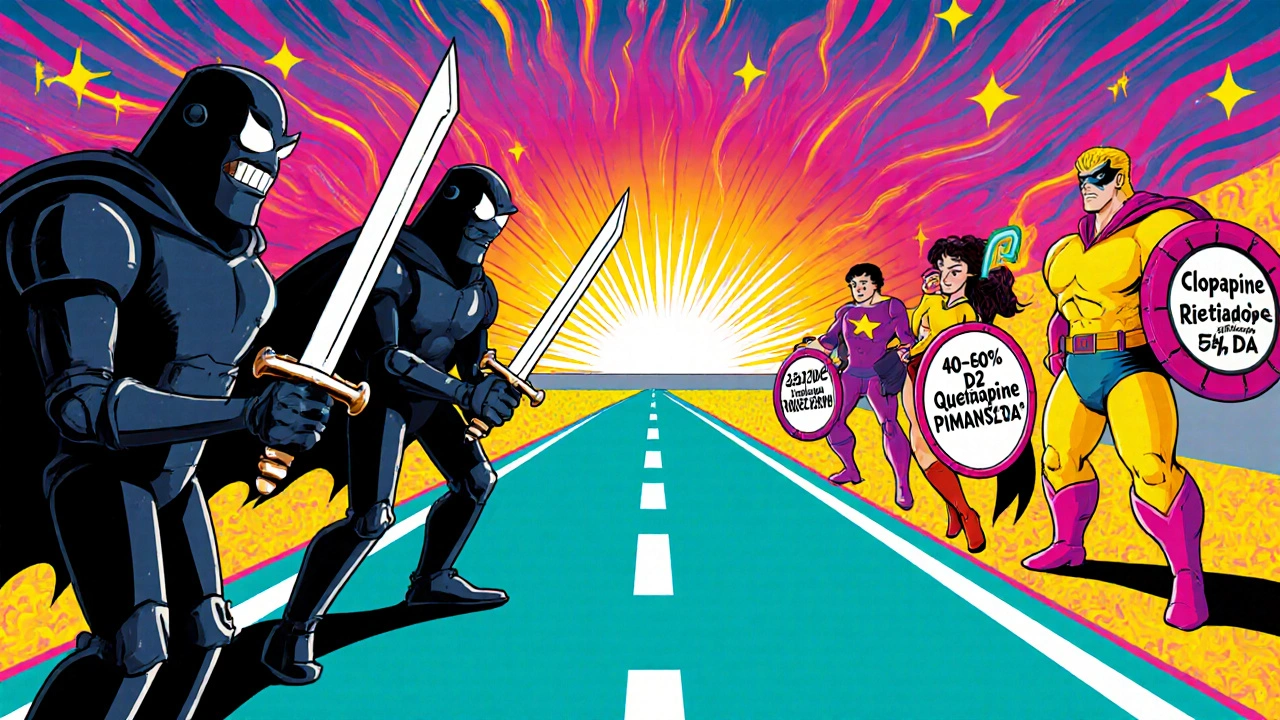
Comparison of Antipsychotic Safety Profiles in Parkinson’s Disease
| Drug | D2 Receptor Occupancy | Average UPDRS‑III Change | Regulatory Status | Key Safety Note |
|---|---|---|---|---|
| Haloperidol | 90‑100 % | +10‑15 points | Not recommended | Severe motor worsening, high mortality |
| Risperidone | 60‑80 % | +7.2 points | Off‑label | Increased mortality (HR 2.46) |
| Olanzapine | ~70 % | +6‑8 points | Off‑label | 75 % experience motor decline |
| Clozapine | 40‑60 % | +1.8 points | FDA‑approved for PDP | Requires weekly CBC (agranulocytosis risk) |
| Quetiapine | ~50 % | ±0 points (dose‑dependent) | Off‑label | Variable efficacy, low motor risk |
| Pimavanserin | None (5‑HT2A) | +0.5 points | FDA‑approved for PDP | Mortality signal; monitor cardiac health |
Step‑by‑Step Management Algorithm
Before reaching for any antipsychotic, follow this three‑stage process recommended by the Parkinson’s Foundation (2023):
- Comprehensive assessment - Review disease stage, current dopaminergic regimen, and presence of hallucinations. Identify reversible triggers (e.g., infections, metabolic imbalance).
- Medication optimisation - Adjust drugs in the following order: anticholinergics → MAO‑B inhibitors → amantadine → dopamine agonists → COMT inhibitors → levodopa. Studies show 62 % of patients resolve psychosis after these tweaks alone.
- Targeted antipsychotic therapy - If psychosis persists, start clozapine 6.25‑12.5 mg at night, titrating to 25‑50 mg daily over 4‑6 weeks, with weekly CBCs. If clozapine is not feasible, try quetiapine 12.5‑25 mg nightly, monitoring for sedation.
For patients who cannot tolerate SGAs, consider pimavanserin 34 mg daily, but counsel about the increased mortality data and obtain baseline cardiac evaluation.
Monitoring Motor Function During Treatment
Parkinson’s clinicians use the UPDRS‑III as the gold standard for detecting motor decline. A practical rule of thumb: if the UPDRS‑III score rises more than 30 % from baseline within two weeks of dose escalation, pause or switch the antipsychotic.
Other monitoring points:
- Weekly complete blood count for clozapine (stop if ANC < 1,500 cells/µL).
- Quarterly ECG for pimavanserin (watch QTc > 450 ms).
- Patient‑reported outcomes: ask daily about new rigidity, slowed walking, or falls.
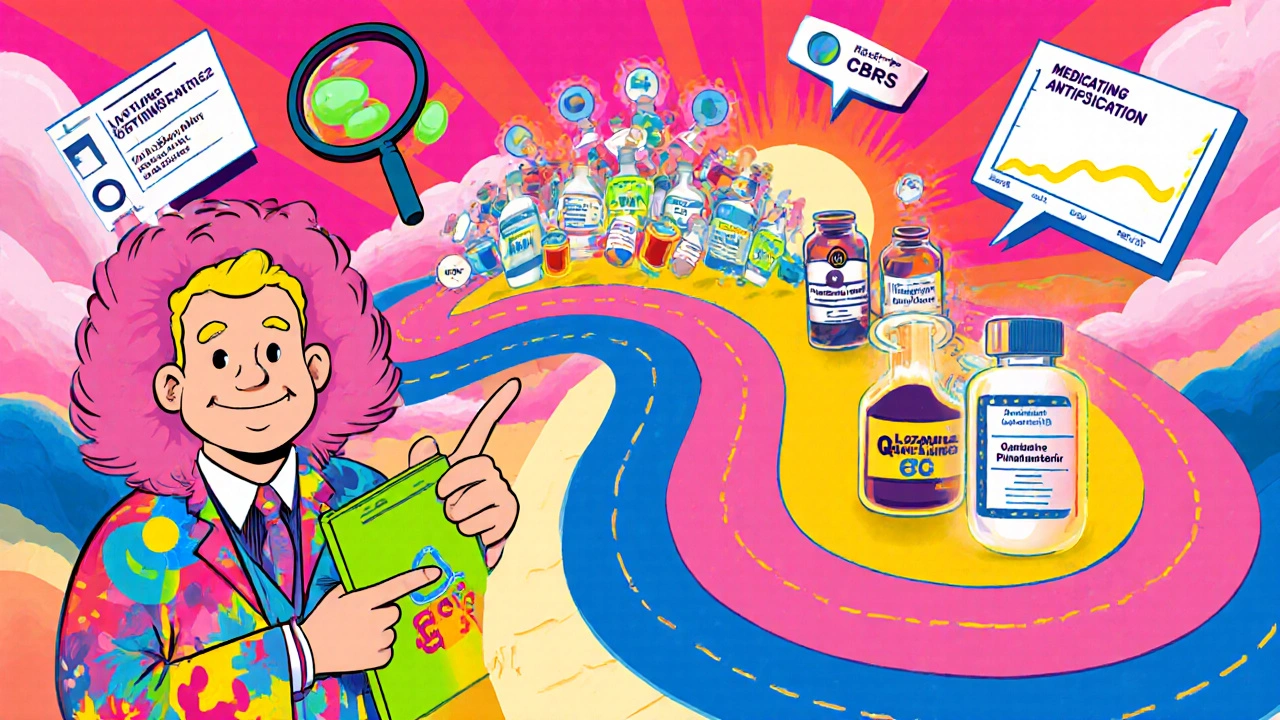
Emerging Therapies on the Horizon
Research is moving toward agents that modulate serotonin or other non‑dopaminergic pathways. Lumateperone, a serotonin‑dopamine‑modulating agent, showed no motor worsening in a phase III HARMONY trial and modest SAPS improvement. If phase III confirms safety, it could become a third‑line option after clozapine, quetiapine, and pimavanserin.
Another avenue is selective 5‑HT2A inverse agonists that bypass dopamine entirely, aiming to keep motor scores flat while treating hallucinations. Early‑phase data look promising, but large‑scale safety data are still pending.
Practical Tips for Patients and Caregivers
- Keep a daily symptom diary noting any new visual hallucinations, voice‑type hallucinations, or changes in walking speed.
- Inform every prescriber (neurologist, psychiatrist, primary care) about all Parkinson’s medications; dose changes in levodopa can alter psychosis risk.
- Never stop an antipsychotic abruptly; taper under supervision to avoid rebound psychosis.
- Use low‑light environments and regular sleep hygiene; many hallucinations worsened by poor sleep.
- Ask about blood‑test schedules early - the weekly CBC for clozapine can feel burdensome but is crucial.
Key Takeaways
- The paradox of Parkinson's disease antipsychotics lies in dopamine blockade worsening an already dopamine‑deficient brain.
- Avoid high‑potency D2 blockers such as haloperidol, fluphenazine, and risperidone whenever possible.
- Clozapine remains the gold‑standard for PDP; quetiapine is a reasonable off‑label choice with careful dosing.
- Pimavanserin offers a dopamine‑free mechanism but carries a mortality warning; use with caution.
- Follow a stepwise medication‑adjustment algorithm, monitor UPDRS‑III, and involve the care team early to protect motor function.
Frequently Asked Questions
Why do antipsychotics make Parkinson’s tremor worse?
Most antipsychotics block dopamine D2 receptors. Parkinson’s disease already suffers from low dopamine in the nigrostriatal pathway, so further blocking intensifies bradykinesia, rigidity, and tremor.
Is clozapine safe for long‑term use?
Yes, when monitored. Clozapine effectively reduces psychosis with minimal motor impact, but it requires weekly blood counts to catch rare agranulocytosis early.
Can low‑dose quetiapine replace clozapine?
Quetiapine may help some patients, especially if clozapine monitoring is impractical. However, evidence for its efficacy is weaker, and it may not control severe hallucinations.
What should I do if my motor symptoms worsen after starting an antipsychotic?
Immediately inform your neurologist. Stop or taper the offending drug, re‑evaluate the dopaminergic regimen, and consider switching to clozapine or pimavanserin if psychosis persists.
Is pimavanserin better than clozapine?
Pimavanserin avoids dopamine blockade, so motor scores stay stable. Yet post‑marketing data show a modest rise in mortality, so clinicians weigh the risk‑benefit for each patient.
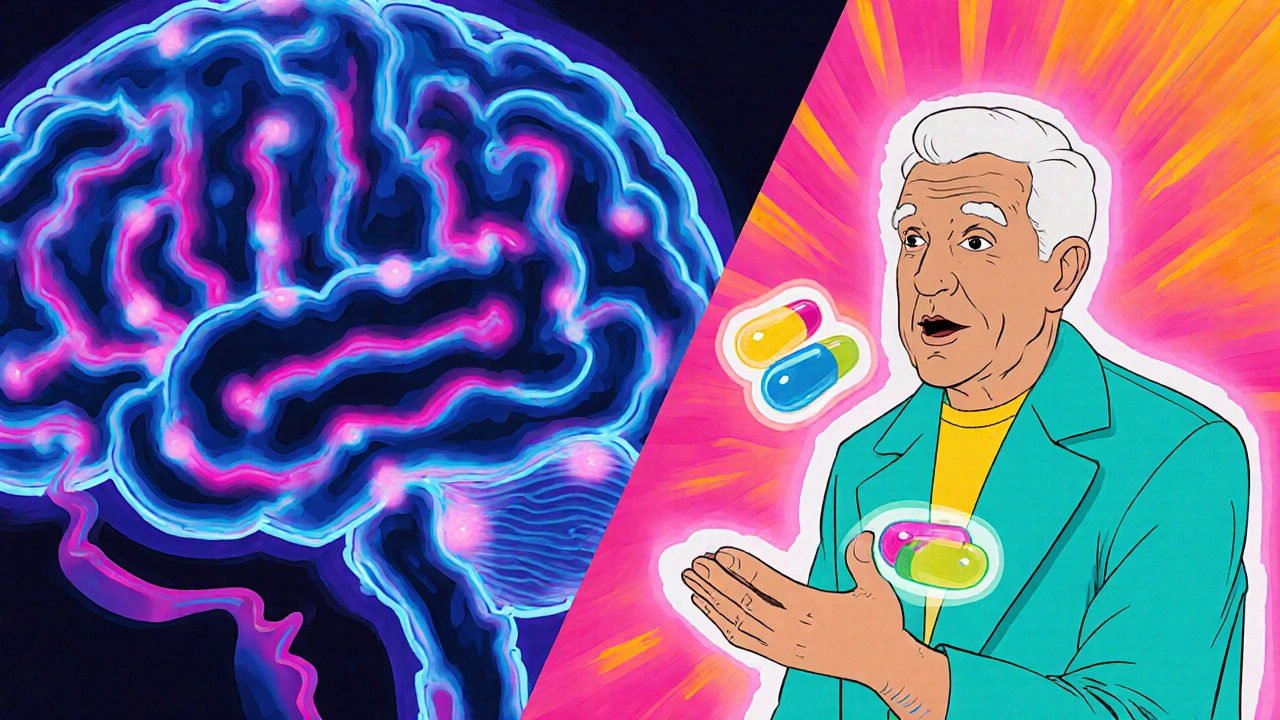
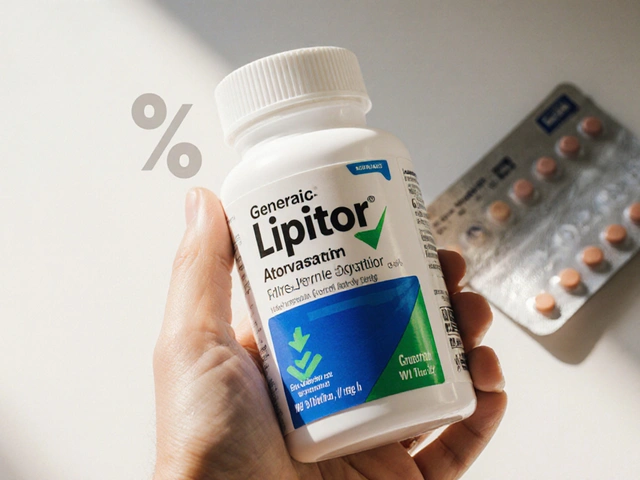

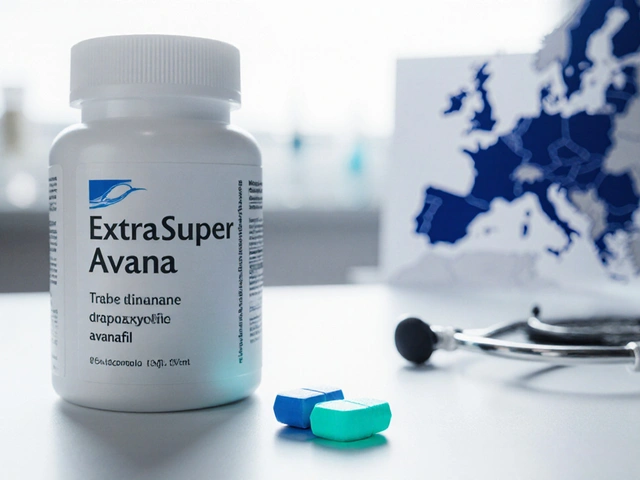
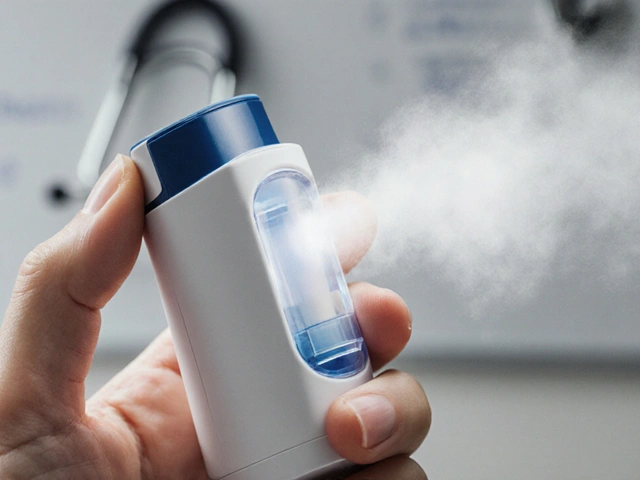
Joe Langner
October 26, 2025 AT 14:30Reading this rundown really lifts my spirits – it’s like a map that finally shows a safe trail through a foggy forest. The way you laid out the dopamine dilemma makes me think of how every decision in PD is a balancing act on a razor‑edge. I love how you highlighted clozapine’s sweet spot, even if it means weekly blood draws – better than losing the ability to button a shirt. It’s also encouraging to see that even the “bad boys” like haloperidol are clearly marked as off‑limits. This kind of clarity definitely helps caregivers feel less lost in a maze of med choices. Keep spreading the word, it definately (definitely) makes a difference.
Barna Buxbaum
November 8, 2025 AT 08:03Great summary! The dopamine‑blocking mechanism is spot on – you’ve captured why first‑generation antipsychotics are a no‑go for Parkinson’s patients. I appreciate the practical step‑by‑step algorithm; it’s exactly what clinicians need in a busy practice. The table is a neat visual aid, especially when juggling multiple meds. Also, the note about pimavanserin’s mortality signal is an essential caution. Thanks for making a complex topic so accessible.
Alisha Cervone
November 21, 2025 AT 01:37The table sums it up nicely
Diana Jones
December 3, 2025 AT 19:10Wow, another deep dive into the neuropharmacology labyrinth – love it. The way you dissect D2 occupancy feels like we’re listening to a high‑octane jazz solo, each instrument (or drug) playing its part in the symphony of symptoms. Kudos for emphasizing the low‑dose quetiapine regimen; it’s the kind of pragmatic jargon that clinicians need when the bedside reality’s screaming “more data, less panic”. And yes, the sarcastic reality check that haloperidol is basically a motor‑wrecker on steroids – you nailed that with a dash of dry humor. Keep the jargon flowing, it feels like intellectual cardio for the brain.
asha aurell
December 16, 2025 AT 12:43The risk hierarchy is clear and concise. Avoid the high‑potency D2 antagonists unless absolutely necessary.